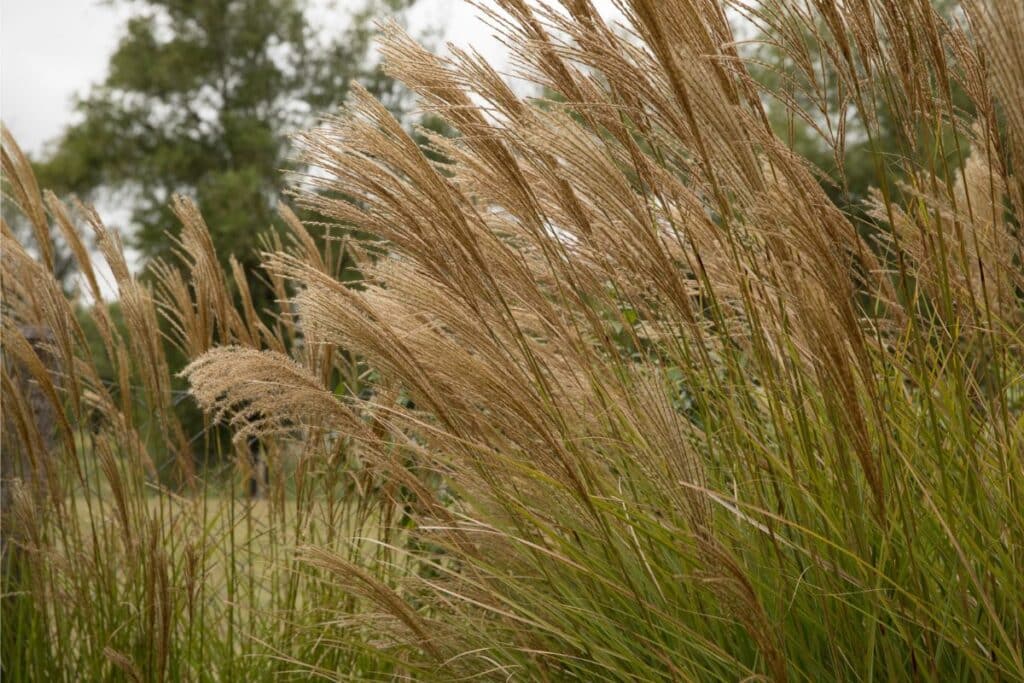Maiden grass (Miscanthus sinensis) is a very popular ornamental grass because it can add lots of cheer with its tall leaf blades and showy flowering plumes.
Gardeners and landscapers love to use this perennial grass variety to create showy spaces. The deciduous grass is functional for adding multi-seasonal interest and will even keep your garden lush during its dormancy stage in winter because the leaves stay upright even when they are all dried out.
It is a great grass variety to include if you want to create showy borders, wild gardens, or natural scapes.
It should be noted that maiden grass is considered invasive in North Carolina, parts of the U.S.A., Tennessee, Washington D.C., and Virginia because it can pose a fire risk, and its growth may stunt the development of other plant species. However, two sterile species of these grass varieties which include ‘Scout’ and ‘My Fair Maidin’, are non-invasive.
Let’s take a closer look at how to grow and care for this beautiful ornamental grass and discuss different ways to use it in your garden.
Plant Facts
| Scientific name | Miscanthus sinensis |
| Common names | Japanese silver grass, Chinese Silver grass, Suzuki, Maiden Grass, Maidengrass, or Eulalia |
| Family | Poaceae |
| Plant Type | Ornamental Grass |
| Height and Width | 4 – 12 feet tall, 4 – 6 feet wide |
| Origin | Asia |
| Flower colors | Gray/silver, pink, red/burgundy, or white |
| Foliage color | Green, variegated, or white |
| Sun Exposure | Full sun, or partial shade |
| Soil Type & pH | Well-drained, clay, loam, or sandy |
| Special features | Low maintenance, good for borders, sedges, or garden fillers |
What Does Maiden Grass Look Like?
This ornamental grass can appear differently throughout the seasons. The grass has a clumping habit and will sprout vivid green upright leaves in early spring. The foliage colors can range from light green to striped depending on variety and will transform into silver-green foliage as the season progresses.
Unique curled seed heads or flowers will start appearing in late summer and fall. These culms can be grey, pink, reddish, or white depending on the variety. The flower heads also tend to be taller than the foliage and can reach heights of up to 12 feet tall depending on the variety.
The grasses become dormant in winter but will still add lots of winter interest because the leaves turn white or wheat-colored but will stay upright. These dead leaves can be left in place to keep garden beds full but should be cut back or pruned when the first growth begins.
Where Does Maiden Grass Grow?
These grasses are native to Asia and China but were also introduced into the United States for ornamental purposes.
Because of its hardy nature, the Chinese silver grass can grow in various sites. It will develop well in sunny areas with lots of moisture but won’t tolerate waterlogged conditions, dry conditions, or shaded positions.
You can find these ornamental grasses on roadsides, in forests, fields, or prairies and it takes well in cold to warm climates in zones 5 – 9.
How to Grow Chinese Silver Grass
The grass variety is pretty easy to grow and care for because it is relatively low-maintenance once it is established. Let’s take a look at how to grow this popular grass.
Propagation
Maiden grass plants should be divided every three years because the center needs air circulation and can start dying out if the clumps become too large. Propagation is also helpful for boosting the growth and health of these ornamental grasses.
Early spring is the best time to dig up the rhizomes for division. You can dig up the rhizomes with a shovel or spade and lift the entire root ball from the ground.
Use a sharp shovel to split the root system in half or into smaller pieces. The smaller plants can then be planted 3 – 6 feet apart in prepared soil.
Soil
You can plant maiden grass in just about any type of soil. It will take well to sandy, loam, or even clay soil and it tolerates alkaline to acidic conditions and it can tolerate excessive moisture but should be planted in well-drained soil to prevent root problems.
Pruning
Most gardeners will keep the dead foliage of this grass during its dormancy stage because the dead white leaves can look aesthetically pleasing. Pruning should be done in early spring when new growth begins or in late winter just before new growth starts appearing.
The easiest way to prune maiden grass is by timing the top of the clumps with a rope. Cut the grasses 3 inches from the ground and try to avoid cutting the new shoots.
How to Care for Maiden Grass
You don’t need to consistently monitor and care for this easy-going grass variety because it has simple growing needs like the following.
Water
Maiden grass can easily become invasive because it is so resilient. This grass variety can tolerate very dry to very moist conditions. For optimal growth rate, the soil should be kept moist but not waterlogged.
During the first year of its growth, the plant can be watered 2 – 3 days a week. When the grasses are fully established, they can tolerate dry periods and will only require watering when the soil is completely dry.
The foliage does, however, look its healthiest if it grows in consistently moist soil.
Sunlight
Chinese silver grass won’t grow well in shaded positions. It prefers a full sun position with a minimum of 6 hours of direct sunlight per day. It will also survive in partial shade with 2 – 6 hours of direct sunlight per day.
Temperature and Humidity
These showy grasses prefer humid conditions but they can tolerate dry spells. They are quite hardy in terms of temperature. With USDA zones 5 – 9, this grass species can tolerate warm to cold temperatures and it will even survive frosty winters.
Fertilizer
There is no need to fertilize maiden grass since it can tolerate poor soil conditions. For optimal growth and health, you can just include lots of organic matter in your garden.
Pests and Diseases
Chinese silver grass isn’t vulnerable in terms of pests and diseases. The chances of this grass variety developing problems is relatively slim. You only need to look out for the following issues.
Rust
Rust can develop on the leaves if too much moisture is left lingering directly on the leaves. To avoid rust, you should try to avoid water splashes directly on the foliage.
Fungus
Maiden grass can also develop fungal problems if it is planted in soggy soil. To avoid fungal growth on these grasses, you should plant them in well-drained soil.
Maiden Grass Companions
If you want to create showy garden spaces filled with interest then you can pair maiden grass with other aesthetically pleasing plants that also develop well in direct sun and moist conditions.
The best companion plants for maiden grass include flowering species like black-eyed susans, blazing star flowers, blanket flowers, and pincushion flowers, or pair it with hairy vetch to create beautiful shrub borders.
Landscaping Ideas for Maiden Grass
This gorgeous wide grass has many garden or landscaping applications. Here is a quick look at some of the most common ways this grass variety is used in landscaping projects.
Wild Gardens
The graceful foliage of these grasses will create a sense of movement in wild garden spaces filled with lots of natural elements like dry streambeds or rocky features. You can also pair it with other tall flowering species to add more vertical interest and diversity to these natural spaces.
Hedges or Borders
The tall grass is ideal for creating a little bit of privacy in your garden or it can be used to create lots of contrast between a lawn and rocky wall or alongside driveways.
The showy grass can be mass planted to create a strong backdrop or it can be kept in clumps and mixed with other ornamental plants to create showy mixed borders or hedges with lots of interest.
Near Water Features
Because this grass variety can tolerate so much moisture, it is often used around water features like fountains, fish ponds, natural ponds, or lakes. The tall grasses can grow right onto the edge of water masses and will survive occasional flooding. The graceful arching stems will look rather striking as they lightly bend over the waters.
Container Gardens
This charming grass variety can also grow well in containers and is great for adding texture to container gardens. You can keep the showy grass in individual containers and position them with other potted plants or you can include filler plants in your garden pots to create interesting mixed containers.
Common Varieties and Cultivars
There are numerous maiden grass varieties and they can range from short dwarfed species like ‘Yaku Jima’ to exceptionally tall species like ‘Fair Maiden’ which typically grow 8 feet tall. Here is a quick look at some of the most common varieties.
- ‘Hinjo’
- ‘Morning Light’
- ‘My Fair Maiden’
- ‘Bandwidth’
- ‘Scout’
- ‘Variegatus’
- ‘Zebrinus’
- ‘Goliath’
Conclusion
Maiden grass can be a wonderful plant to include in your sunny garden. This grass is known to attract birds and small mammals and it will add lots of vertical interest and texture to your garden bed.
We hope that this guide gave you all the information you need on the best way to grow maiden grass and the best way to keep it in great shape.
References
Reference List
North Carolina Extension Gardener Plant Toolbox – Miscanthus sinensis – https://plants.ces.ncsu.edu/plants/miscanthus-sinensis/
Edward F. Gilman – Miscanthus Sinensis Maiden Grass – https://edis.ifas.ufl.edu/publication/FP405
RHS – Miscanthus sinensis Eulalia – https://www.rhs.org.uk/plants/95355/miscanthus-sinensis/details
EOL – Chinese Silvergrass – https://www.eol.org/pages/1115038
Southeast Exotic Pest Plant Council Invasive Plant Manual – Chinese Silver Grass – https://www.se-eppc.org/manual/MISI.html
Close
*image by gdemiceu/depositphotos







